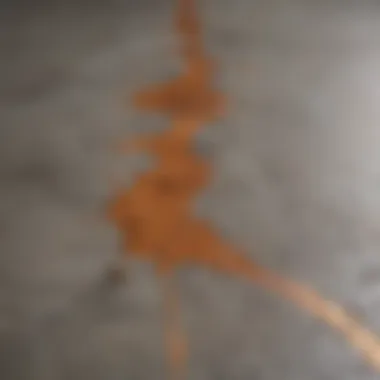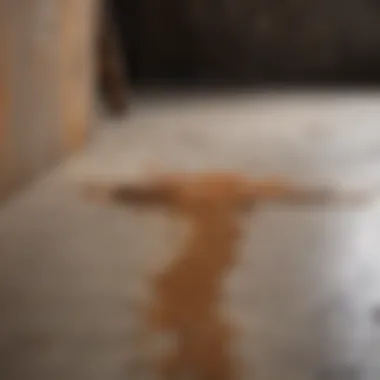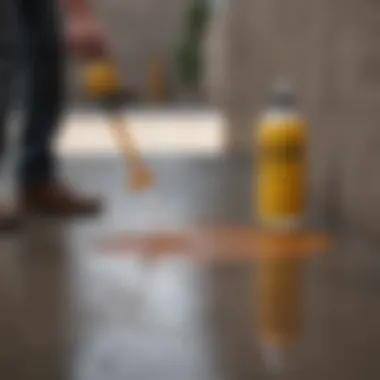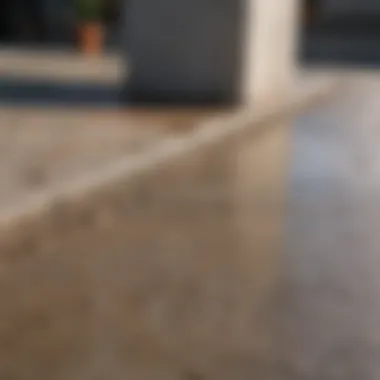Effective Techniques for Removing Rust Stains from Concrete


Intro
The presence of rust stains on concrete surfaces is a common issue that many homeowners encounter. These stains, often caused by the reaction of moisture with iron-containing materials, can significantly diminish the visual appeal of driveways, patios, and walkways. Understanding the origins of rust stains is essential in formulating effective cleaning strategies and preventing future occurrences. This article delves into the specifics of rust stain removal, exploring both chemical solutions and natural alternatives, while providing maintenance tips to keep your concrete surfaces pristine.
Design Inspiration
When it comes to concrete surfaces, the aesthetic appeal greatly influences the overall look of your property. Consequently, maintaining clean and stain-free concrete is crucial for creating a welcoming environment.
Trending Styles
The trend towards outdoor living spaces has led to an increased focus on maintaining the beauty of concrete. To combat rust stains, consider using acid stain techniques that not only remove stains but also enhance the natural color of concrete. This can make the surface look vibrant and fresh.
Color Palettes
Choosing the right color palette can help in minimizing the visibility of any stains. Earthy tones, such as beige, gray, or olive green, can camouflage rust stains better than lighter shades. Using a sealer with pigment can amplify the visual impact while safeguarding against future stains and corrosion.
Practical Tips
To address rust stains effectively, it is essential to employ the correct methods and tools suitable for your concrete surface.
Maintenance & Care
Regular maintenance is key in preventing rust stains:
- Seal the concrete: Applying a high-quality sealant can protect the surface from moisture intrusion and rust formation.
- Frequent cleaning: Sweep and wash the surfaces regularly to remove debris and potential rust sources.
- Immediate action on spills: If you notice rust from metal furniture or tools, clean it immediately to prevent staining.
Budgeting & Planning
When planning a cleaning regimen for rust stains, consider your budget. Chemical solutions often come with higher costs, but they are usually more effective than natural methods. Yet, if you prefer a DIY approach, natural methods using household products can be quite economical.
- Determine your budget before starting the project.
- Prioritize your cleaning strategy — consider cost versus effectiveness.
Regular care and maintenance can prevent more extensive and expensive restoration later.
Understanding Rust Stains on Concrete
Rust stains on concrete surfaces can be a significant problem, compromising the appearance and integrity of various installations. Understanding rust stains is crucial for homeowners and property managers alike. Knowing the root cause of these stains allows for better decision-making in cleaning and maintenance. Moreover, it helps in implementing preventive measures that can save time and resources in the long run.
Rust stains are primarily a result of oxidation, where iron or steel comes into contact with moisture and oxygen. Once rust begins to form, it can leach into concrete, leading to unsightly marks that are often challenging to remove. This article will delve deeper into the causes, and solutions, and provide effective cleaning techniques to manage rust stains effectively.
Key benefits of understanding rust stains include:
- Informed Cleaning Choices: Knowing what causes the stain helps select the right cleaning method.
- Prevention Strategies: By understanding the factors contributing to rust, effective maintenance practices can be established.
- Enhanced Aesthetics: Clean concrete surfaces significantly improve the visual appeal of any property.
What Causes Rust Stains?
Rust stains are caused by oxidation processes, occurring when ferrous metals are exposed to moisture. Common scenarios include:
- Iron pipes or rebar embedded in concrete
- Metal furniture left on concrete surfaces
- Any iron-rich material coming into contact with wet surfaces
As water seeps into concrete, it can carry iron compounds to the surface. Upon evaporation, these compounds crystallize and create stains. Recognizing the specific sources of rust stains is the first step in effective remediation.
Common Locations for Rust Stains
Rust stains can appear in various places around a property, with common locations including:
- Driveways: Often the site of metal tools resting on the surface.
- Patios: Furniture or grills made of iron can leave stains upon rusting.
- Basements: Where moisture and iron structures often coexist.
- Sidewalks: Metal reinforcements in concrete can result in rust migration.
Identifying where rust stains are likely to occur helps in monitoring and addressing issues before they become severe. Homeowners should inspect these areas regularly, ensuring that any potential sources of rust are managed properly.


"An informed approach to maintenance can significantly extend the life of concrete surfaces and improve overall property aesthetics."
In summary, understanding the origins and locations of rust stains on concrete serves as a foundation for effective cleaning and preventive strategies. This knowledge is essential not only for restoration but also for ongoing maintenance.
Assessing the Severity of Rust Stains
Understanding the severity of rust stains is a crucial step in the cleaning process. Not all stains are created equal; some may be superficial, while others may penetrate deeper into the concrete. This assessment enables homeowners to select the most appropriate cleaning techniques and materials for effective removal. Ignoring the severity can lead to inadequate cleaning attempts, which could result in wasted time and resources, as well as damage to the surface.
Furthermore, assessing rust stain severity informs the need for additional treatments, such as sealants or resurfacing processes, that may be required post-cleaning. In this way, an initial evaluation can have a lasting impact on the appearance and durability of concrete surfaces.
Visual Inspection Techniques
Visual inspection is the first step in evaluating rust stains on concrete. By closely examining the affected areas, it's possible to determine the extent of staining and identify if the rust is growing in depth or scope. Here are key points to consider:
- Color Variation: Different shades of rust can indicate varying levels of severity. Darker or deeper red stains often suggest more significant corrosion below the surface.
- Size and Spread: Take note of how large the stain is and whether it is spreading further. Larger and expanding stains typically require immediate attention.
- Surface Texture: Touching the stain can provide insight. If the concrete feels rough or pitted in that area, the rust may have penetrated deeper.
Use a flashlight to enhance visibility in shaded areas or crevices. Keeping a notebook for observations will also help in comparing old and new stains over time.
Identifying Stain Type
Identifying the type of rust stain is pivotal for selecting the right cleaning approach. Different rust stains may originate from various sources. Here are the common types:
- Surface Rust: Often resulting from metal objects left on concrete for too long, leading to surface staining that is typically easier to remove.
- Leaching: Caused by water-soluble rust from corroded rebar or nearby metallic structures. This is more complex as it can reappear even after cleaning.
- Environmental Stains: Stains that result from elements like water runoff or pollution can often be broader and stem from multiple sources.
To identify the type:
- Examine the source of moisture or flow in the vicinity. Are there any metallic tools or furniture nearby?
- Assess whether the stains appear to have a pattern, suggesting regular leaching from another structure. Addressing the origin of the stains may be necessary to prevent recurrence.
These assessment techniques not only facilitate effective cleaning but also enhance overall maintenance strategies against future rust-related issues.
Safety Precautions Before Cleaning
Before engaging in any rust stain removal on concrete, it is vital to address safety precautions. These measures not only protect the individual performing the task but also ensure the integrity of the surrounding area. Many cleaning solutions, especially those that are chemical-based, can be hazardous if not handled properly. Following safety protocols minimizes the risk of injury or unintended consequences.
Furthermore, working with cleaning agents requires awareness about skin contact, inhalation of fumes, and potential reactions with other substances. A well-structured safety plan guarantees an effective cleaning experience without compromising personal safety.
Protective Gear Essentials
Using protective gear is a critical step in ensuring safety during the cleaning process. Essential items include:
- Gloves: Opt for chemical-resistant gloves to safeguard your hands from harsh substances. Nitrile gloves are often a suitable choice.
- Eye Protection: Safety goggles should be worn to prevent any splashes or fumes from irritating your eyes. Clear lenses can provide visibility without compromising safety.
- Respiratory Protection: In case the cleaning agents emit strong fumes, a mask or respirator is advised. Ensure it is rated for chemical vapors, especially for solvent-based cleaners.
- Coveralls: Wearing long sleeves, long pants, and, if possible, coveralls can protect your skin from splashes and exposure.
It's prudent to choose high-quality gear that meets industry safety standards. Inspect your protective equipment before use to ensure it is not damaged.
Ventilation Requirements
Proper ventilation is essential when using cleaning products with strong fumes. Adequate airflow helps to disperse any harmful vapors, reducing inhalation risks. Here are some considerations:
- Open Windows and Doors: If cleaning indoors, ensure windows and doors are open to allow fresh air circulation. This helps to replace stale air with oxygen.
- Use Fans: Employ fans to improve airflow, particularly if the area lacks adequate natural ventilation.
- Limit Exposure Time: Plan scheduled breaks away from the cleaning area. This can be particularly helpful in high-fume situations.
- Avoid Confined Spaces: If possible, avoid cleaning rust stains in tight or enclosed areas where fumes can accumulate.
Ensuring your space is well-ventilated not only enhances safety but also improves the effectiveness of the cleaning process.
Chemical Cleaning Methods
Chemical cleaning methods play a crucial role in effectively removing rust stains from concrete surfaces. The stains are often deeply embedded and can be resistant to mere scrubbing or natural cleaning solutions. When opting for chemical methods, homeowners can benefit from faster results and less physical effort. However, it is essential to understand that using the wrong chemical can damage the surface or environment, so knowledge and care are paramount.
Using Commercial Rust Removers
Commercial rust removers are formulated specifically to tackle rust stains on various surfaces, including concrete. They typically contain strong acids or other active ingredients designed to dissolve rust effectively. These products are easy to use, often requiring minimal effort beyond application and rinsing. Many homeowners find these solutions more convenient than DIY alternatives.


However, it’s crucial to pick reputable brands and read the instructions carefully. Some chemical rust removers may release fumes, so ensuring proper ventilation is very important when using these products. Moreover, always conduct a small test area first to see how the concrete reacts.
Acid-Based Solutions
Acid-based solutions, such as muriatic acid or phosphoric acid, can be effective against rust stains. Muriatic acid is a diluted form of hydrochloric acid and is often employed in various cleaning applications. It works by breaking down iron oxide, which is the compound responsible for rust stains.
Using acid-based solutions does require some precautions. The acid can corrode other materials, which means careful application and protection of surrounding areas are essential. Wear protective gear, including gloves and goggles, to safeguard against splashes. When using acid, neutralization afterwards with a baking soda solution is advisable to prevent damage to the concrete surface.
Oxalic Acid Application
Oxalic acid is another viable option for rust stain removal. It is a naturally occurring compound and is also effective in addressing discoloration caused by rust. One attractive quality of oxalic acid is its relatively mild nature compared to harsher acids. The application is usually straightforward. You can mix the powder with water to create a paste and apply it directly to the rust stains. Let it sit for a while before rinseing it off.
When using oxalic acid, it’s a good idea to test a small area first, as variations in concrete type and age can yield different results. Always follow up with thorough rinsing to remove any residual acid, ensuring that no additional damage occurs to the concrete.
"Understanding the correct application of chemical cleaning methods is essential. Misuse or neglect can lead to further complications instead of solving the rust problem."
In summary, while chemical cleaning methods can provide effective solutions to rust stains, they must be employed with caution. It's important to prioritize safety and follow the product guidelines closely, to avoid damaging both the concrete surface and the environment.
Natural Cleaning Alternatives
Natural cleaning alternatives for removing rust stains from concrete offer a practical approach that emphasizes environmental safety and effectiveness. Homeowners often prefer these methods as they reduce the use of harsh chemicals while still achieving satisfactory results. Using naturally derived products can be less abrasive on surfaces, potentially prolonging the longevity of your concrete. Moreover, these alternatives tend to be cost-effective, making them accessible for regular maintenance. It's essential to consider factors like the severity of the rust stains and the specific concrete type before choosing a natural cleaner.
Baking Soda Method
Baking soda is a common household item that acts as a mild abrasive and a pH-neutral cleaner, making it suitable for tackling rust stains on concrete. The method is simple and typically effective. To use it, you can create a paste by mixing baking soda with a little water. Once you have your paste, apply it directly onto the rust stain. Let it sit for about 30 minutes to an hour. The baking soda will work on breaking down the stain, making it easier to scrub away. After the waiting period, use a stiff brush to scrub the area and then rinse with clean water. This method is non-toxic, which is an added benefit, especially for households with pets or small children.
Lemon Juice and Vinegar Solution
The acidity in lemon juice and vinegar can be a powerful ally in removing rust stains from concrete. To create a cleaning solution, mix equal parts of both lemon juice and white vinegar in a spray bottle. Apply the mixture generously to the stained area. The acid helps to dissolve the rust, while the natural fragrance of lemon juice acts as a refreshing scent. Allow this solution to sit for at least 30 minutes. Afterward, scrub the stain with a brush and rinse the area. Note that this method may need several applications for tougher stains. Both ingredients are widely available, making this cleaning strategy accessible for almost anyone.
Using Hydrogen Peroxide
Hydrogen peroxide is another natural cleaning agent that can effectively tackle rust stains. It acts as a mild bleach and an oxidizer, which can help lift the reddish-brown discoloration from your concrete. For application, use a solution of 3% hydrogen peroxide. You can simply pour it directly over the stain or apply it with a cloth. Let it sit for 30-60 minutes—be aware that prolonged exposure may lighten the concrete, especially if used excessively. After its effect time is over, scrub the stained area with a brush and rinse thoroughly with water. Using hydrogen peroxide is particularly useful when dealing with smaller spots or lighter rust stains.
Tip: Always test these natural methods on a small, inconspicuous area first to ensure that they will not discolor or harm the concrete.
Mechanical Cleaning Techniques
Mechanical cleaning techniques are crucial in the removal of rust stains from concrete. They provide homeowners with options that do not rely solely on chemicals or natural remedies. These methods tend to be effective in removing stubborn or deeply embedded stains. Furthermore, they can be less time-consuming than other methods, depending on the severity of the rust stain. The benefits of mechanical cleaning include not only efficiency but also a lower chance of damaging the concrete surface when done properly.
Before diving into the mechanical techniques, it is important to consider the condition of the concrete and the nature of the stain. This involves assessing whether the stain is superficial or penetrating. Choosing the right mechanical approach takes some knowledge and care.
Scrubbing with Brushes
Scrubbing with brushes is a traditional yet effective method for cleaning rust stains. By using a stiff-bristled brush, homeowners can scrub the affected area vigorously. This action helps to lift and dislodge rust particles from the concrete surface.
When choosing a brush, consider the following factors:
- Bristle Material: Brushes can be made from nylon, wire, or natural fibers. Nylon is ideal for basic cleaning, while wire brushes are better for tougher stains.
- Brush Size: A smaller brush can help get into tight spaces, but a larger brush will cover more area faster.
- Handle Length: A long handle allows for better leverage, reducing strain on your back during the process.
The technique involves applying a cleaner or a homemade solution on the stain before scrubbing. A circular motion often yields the best results. It’s crucial to maintain a consistent pressure to ensure that the rust is being adequately addressed.
Pressure Washing Guidelines
Pressure washing is a powerful option for removing rust stains from concrete. This technique utilizes high-pressure water spray to clean surfaces. However, caution is required, as improper use can result in damage to the concrete or surrounding areas.
Here are some guidelines to follow when using a pressure washer:
- Set the Right Pressure: Most concrete cleaning can be done at a pressure between 2,500 and 3,000 psi. Higher pressure can lead to etching of concrete.
- Use the Right Nozzle: A wide-angle nozzle (25 degrees or wider) is recommended for cleaning without damaging the surface. A narrow nozzle could concentrate the force too much.
- Keep Distance: Maintain a distance of at least 12 to 18 inches from the surface to avoid pressure damage.
- Work Methodically: It is best to work in sections and move back and forth rather than staying in one spot too long.


"Mechanical cleaning techniques, when done right, can restore the original look of your concrete surfaces without introducing harsh chemicals."
These mechanical methods complement chemical and natural techniques effectively, forming a comprehensive approach to rust stain removal.
Evaluating Effectiveness of Cleaning Solutions
Evaluating the effectiveness of cleaning solutions is pivotal when addressing rust stains on concrete. In the context of this article, it allows homeowners to make informed choices. Choosing the right method can save time, reduce repeated effort, and prevent potential damage to the concrete surface. This evaluation plays a significant role in ensuring that the chosen technique will yield satisfactory results without introducing other issues.
When selecting a cleaning solution, consider the composition, application process, and likely impact on the surrounding environment. Not all solutions suit all types of rust stains or concrete finishes. Therefore, a careful evaluation process is essential.
Testing Small Areas
Before committing to a full cleaning application, testing in small, inconspicuous areas of the concrete is important. This minimises the risk of broader damage or staining. Use the selected solution on a small patch and observe the response over time. Here are a few steps to follow:
- Choose an inconspicuous spot on the concrete surface.
- Apply the solution according to the manufacturer’s instructions.
- Wait and observe for any changes in color, texture, or integrity of the concrete.
If the small test proves successful, the same method can be applied more broadly. If adverse effects occur, consider alternative methods that could potentially work without harming the surface.
Post-Cleaning Inspection
After completing the cleaning process, conducting a post-cleaning inspection is essential. This ensures that all rust stains have been adequately removed and that no unwanted effects occurred during cleaning. Here are some key points to consider:
- Check for remaining stains: Ensure there are no residual rust marks that might require additional treatment.
- Assess the surface condition: Look for any signs of damage such as chips, cracks, or discoloration that could indicate the solution caused harm.
- Evaluate overall appearance: The goal is a clean and uniform finish. Any inconsistencies should be addressed promptly.
Remember, the inspection phase is as important as the cleaning itself. This can inform future maintenance decisions and solutions needed.
Conducting a thorough post-cleaning inspection can help refine methods for future rust removal efforts. It is during this stage that one can adapt and choose better-suited solutions based on concrete reactions.
Preventing Rust Stains in the Future
Rust stains on concrete surfaces can be both unsightly and damaging. To maintain the appearance and longevity of concrete, it is essential to implement preventive measures. Prevention is often more effective than remediation. By taking simple steps, homeowners can protect their concrete from future rust stains, saving time and costs associated with cleaning.
Applying Sealants
Sealants play a critical role in protecting concrete surfaces from rust stains. When applied correctly, they provide a barrier that prevents moisture and contaminants from penetrating the surface. This is vital because rust typically derived from iron and steel can seep through porous concrete when exposed to water. The act of sealing not only protects against rust but also enhances the overall durability of the concrete.
When selecting a sealant, it is important to choose one that is specifically designed for exterior use. Products such as Silane-based or polyurethane sealants are highly effective. These sealants often have water-repellent properties and can withstand harsh weather conditions.
Application tips:
- Clean the surface before applying to ensure proper adhesion.
- Use a spray or roller for even coverage.
- Follow the manufacturer's instructions regarding drying time and reapplication.
Regular Maintenance Practices
In addition to applying sealants, regular maintenance can significantly reduce the chances of rust stains. This involves routine inspections and timely cleaning. Identifying early signs of rust can prevent extensive damage. Simple practices such as sweeping, washing, and inspecting for leaks can go a long way in maintaining your concrete surfaces.
Key maintenance practices include:
- Sweep regularly: Keep the surface free of debris that can hold moisture.
- Wash periodically: Use a mild detergent and water solution to clean the concrete. This helps remove dirt that could harbor rust.
- Inspect for leaks: Look around metal fixtures, gutters, and downspouts for potential leaks that might create rust stains.
In summary, preventing rust stains involves a combination of applying protective sealants and adhering to regular maintenance practices. By taking these proactive steps, homeowners can ensure their concrete surfaces remain stain-free and visually appealing for years to come.
Culmination
Rust stains on concrete surfaces can be unsightly and may diminish the overall appeal of your property. As explored in this article, understanding the causes and nature of these stains is critical for effective removal. There is no one-size-fits-all approach to restoration; the circumstances can vary, and so must the methods employed.
In the previous sections, we covered a range of cleaning techniques, from chemical solutions like oxalic acid and commercial rust removers to eco-friendly alternatives such as baking soda and vinegar. Each method has its own set of advantages and disadvantages. For instance, while chemical agents may offer quick results, they might also pose risks to surrounding vegetation or the environment. On the other side, natural remedies typically require more time but are gentler and often safer for long-term use.
Moreover, we discussed mechanical cleaning techniques and their necessity for persistent stains. Methods like scrubbing and pressure washing can effectively remove rust, provided they are executed carefully to avoid damaging the concrete surface.
It's also important to consider preventative measures. Applying sealants or establishing a regular maintenance routine can significantly reduce the chances of rust reappearing. This proactive approach not only saves time and resources in the long run but also contributes to maintaining the aesthetic quality of the concrete.
"Prevention is always better than cure," and this holds true for concrete care as well.
In summary, effective rust stain removal involves a combination of understanding underlying causes, selecting appropriate cleaning methods based on the situation, and implementing preventive strategies. By applying the insights discussed, homeowners can ensure their concrete surfaces remain clean and visually appealing.















